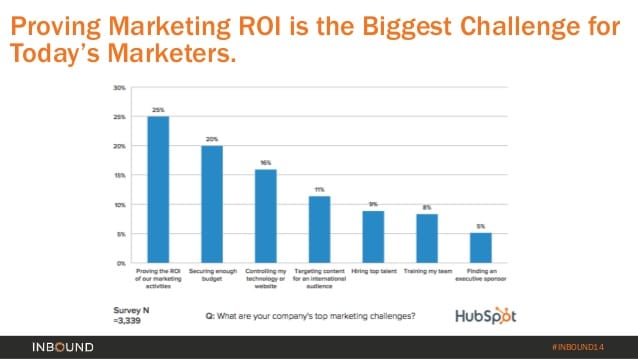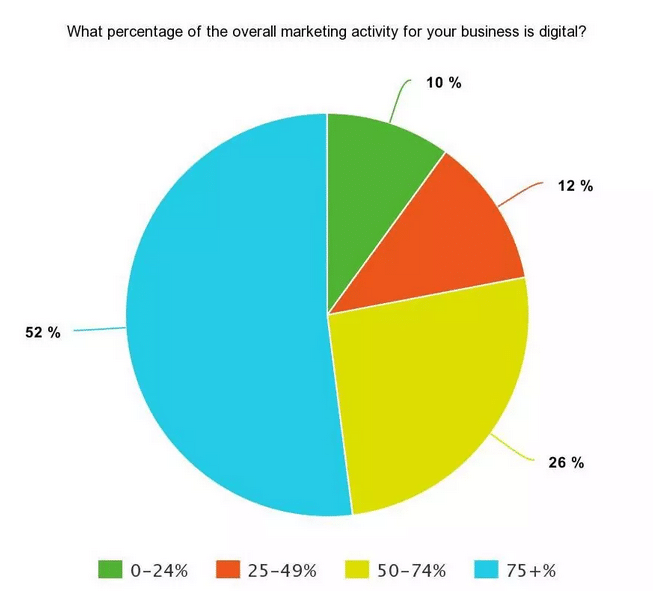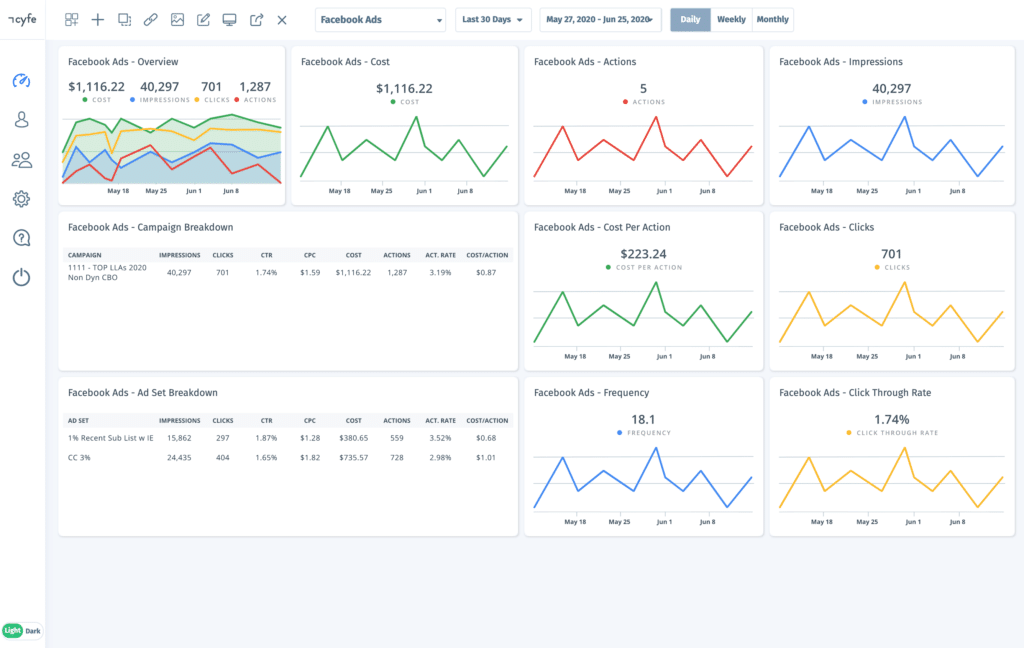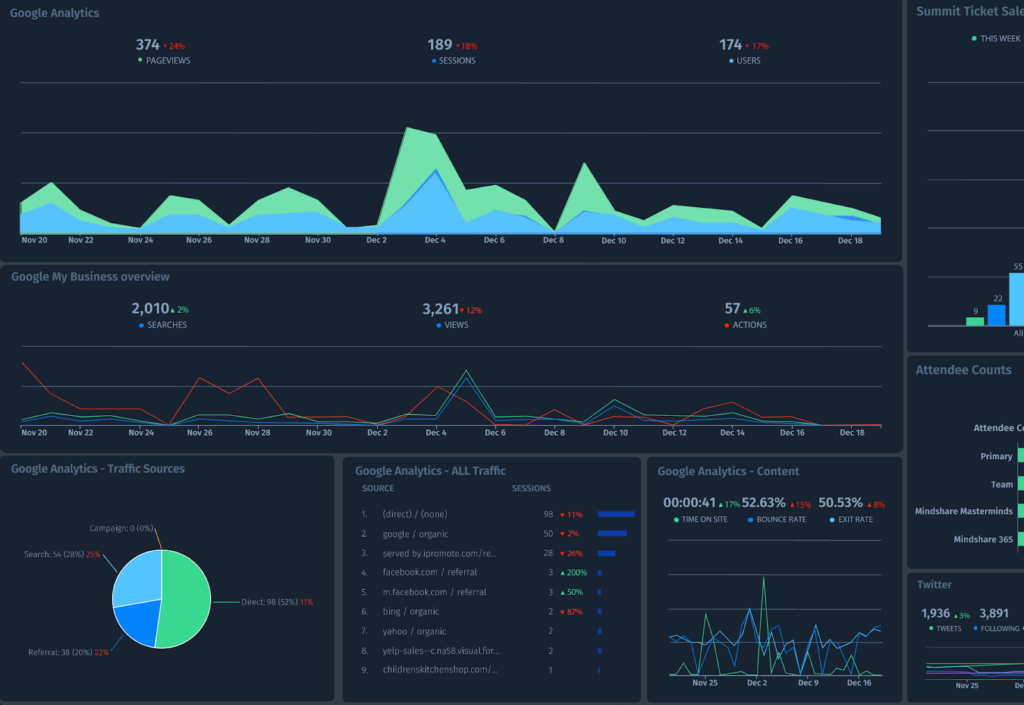One of the most difficult tasks of a marketer or marketing agency is to prove the return on investment (ROI) of marketing campaigns to a client. In fact, according to a survey from Hubspot’s Inbound conference, 25% of marketers say proving marketing ROI is their biggest challenge:

Clients want to ensure that they’re getting the best possible value for their money. You’re going to need a more robust method of proving marketing ROI to better understand your campaigns, keep your clients happy, retain their custom, and sign new clients in the future.
So where do you start? Let’s begin by defining our terms.
Table of Contents
What is Marketing ROI?
ROI is a popular marketing buzzword. But do you understand how to calculate it? Do you understand what constitutes a “good” ROI? If not, you’ve come to the right place.
In a nutshell, return on investment (ROI) is how we measure the total profit earned from an investment or campaign. There’s a simple formula to calculate marketing ROI:

Source: The Online Advertising Guide
We multiply by 100 at the end of the equation because ROI is typically expressed as a percentage.
If you want to prove the value of your services to your clients, it’s essential that you track ROI for each campaign.
But how do you track ROI?
It’s harder to track the ROI of some types of campaigns than others. Billboards, television commercials, radio ads, and direct mail are typically much harder to track than digital tactics like email campaigns, content marketing, and search engine optimization.
However, your clients are going to want to know and understand their marketing ROI no matter what kind of campaign you’re running. Therefore, it’s best to get to grips with reporting on ROI as soon as possible.
If you are running a marketing campaign for your clients using some of the traditional outbound tactics that we outlined above, there may be some guess work involved. There are several strategies you can utilize to gain a more accurate idea of your ROI from these campaigns. Here are a few suggestions:
- A special phone number dedicated to that campaign
- A unique landing page
- A “code word” that can be used for the customer to claim a special offer or discount.
For the purposes of this article, we’ll be focusing primarily on digital channels. Given that 78% of marketers spend at least half of their marketing budget on digital, these channels are likely to be where your clients are investing the most:

Source: Search Engine Journal
When it comes to ROI, digital campaigns tend to be somewhat easier to track. You’ll need to collect the appropriate data, analyze it, and report back to your client.
Read on for our detailed 7-step plan to help you report on marketing ROI to your clients:
Determine your KPIs
Before you can achieve your goals, you need to know exactly what they are. Therefore, you should begin any marketing campaign by working with your client to determine the key performance indicators (KPIs) they’ll be using to measure success. KPIs are quantifiable measurements that you can monitor to track your campaign’s performance. In some cases, your client will already know the KPIs that matter to them. In others, you’ll need to work with the client to develop them.
Though all your KPIs may not be included in the final financial ROI calculation, they are closely intertwined and you will need to report them. Here’s an example: let’s imagine one of your KPIs is increasing organic traffic to your client’s website. While the increase in website traffic may not be used directly to calculate gross profit, it shows you where that gross profit increase came from and answers questions such as:
- How much more traffic is needed in order to increase profits by X%?
- What would happen if the client invested in increasing their organic traffic by X visitors per month?
- What is the client’s conversion rate for organic traffic? In other words, how many organic visitors must they attract in order to convert one visitor into a customer?
Therefore, if you do not know your KPIs, stop and determine them now. The rest of your reporting to your client will depend upon them.
Determine your client’s marketing costs
Now it’s time to dive more deeply into the marketing return on investment equation.
First, you must understand how much your client is paying out in marketing costs and how that expenditure breaks down. Depending on the type of campaign you’re running, this may include:
- Media costs
- Creative costs
- Printing costs
- Software or technical costs
- Staff time
- Agency fees
- Cost of sales
There may also be others I have not listed, depending on the nature of your client’s business. You’ll need to get a full picture if you want to determine your marketing ROI accurately.
It’s a good idea to determine both overall costs for your campaign, and more granular costs for each element (e.g., social media scheduling tools for social marketing, Google ads, customer experience software, reputation management software, and so on). When you report back to your client, you’ll need to present an overall ROI for their whole campaign as well as ROI for each tactic.
This will help you and your client to understand which tactics are working well, which have room for potential growth, and which are not working and can be dropped.
Establish an ROI threshold
Your ROI threshold is the minimum expected rate of return for any given campaign. You’ll need to use this as a benchmark of how you’re doing. This will get you and your client on the same page about expectations and allow you to adjust any campaigns that aren’t seeing the expected rate of return. I recommend setting a base ROI threshold, and then an ideal goal that you’d like to achieve.
Many agency marketers I know have had struggles with unrealistic client expectations. Most often, this takes the form of expecting miraculous results on a shoestring budget. For that reason, setting expectations is essential.
Creating an ROI threshold with your client will ensure that their expectations are in the realm of what you can actually achieve with the available resources. It will also open the door to conversations about higher budgets for higher performing campaigns further down the road. And what’s a win-win situation!
Calculate the projected CLV from each marketing channel
One of the metrics that clients, especially small business owners, neglect the most often is customer lifetime value (CLV). CLV is the total value a business will derive from the entirety of their relationship with a customer.
Many people make the mistake of considering a single sale as the total value derived from that customer. If your client is stuck in this mindset, it’s your job to help them understand CLV. If they nurture the relationship with the customer, that first sale is unlikely to be the last. As marketers, you’re trying to attract a customer for life, not just a one-off sale.
Once you’ve got buy-in from your client on the importance of CLV, it’s time to calculate the projected lifetime value of a customer from each campaign. For a predictive CLV, we use this calculation:
[(Avg. Monthly Transactions X Avg. Order Value) Avg. Gross Margin] x Avg. Lifespan in Months
You’ll need to work closely with your client to generate and understand these figures. CLV is by nature imperfect, since all customer journeys do not follow the same neat trajectory. However, CLV will help you identify where your most valuable customers are coming from, and show your client the value of your work far beyond that first purchase.
Create an ROI dashboard
Once you’ve established your KPIs, ROI threshold, budget, and projected CLV, it’s time to create an ROI dashboard. Depending on the complexity of each campaign and its tracking, you might wish to create a single dashboard for each client, or a different one for each campaign.
Something that truly great marketing agencies tend to do is offer clients the ability to monitor their performance in real time. While providing monthly analytics is fine, most clients would rather be able to check in at any time to see how things are going.

Cyfe provides an all-in-one business dashboard solution using real-time data and the metrics and KPIs you specify. It integrates seamlessly with a wide range of other systems including Salesforce, Google Ads, Xero, Quickbooks, and many more. This means you can track results on everything from sales KPIs to social media ads, and from SEO KPIs to finance.
Measure ROI of each tactic and campaign
Remember: measuring the overall campaign success and ROI isn’t enough. It’s also essential to measure each tactic individually. For example, aspects you might choose to measure separately include:
- Email marketing
- Social media marketing
- Organic traffic from doing SEO
- Paid Google ads
- Print ads
And so on. Not all companies will use all strategies, of course. But even if you use only two or three, it’s best to monitor the individual ROI of each one.
Why? Here are just a few great reasons to do this:
- It will allow you to identify the tactics that are costing money but not producing the desired results. You can then scale back on these tactics or cut them entirely.
- It will identify the areas and tactics that are outperforming your expectations. You can then pivot to focusing more on these strategies and perhaps invest more of your budget in them.
- It will demonstrate to your client the benefit of investing in multiple marketing channels instead of putting all their eggs in one basket.
You can use your Cyfe dashboards to track each campaign element individually, if you wish. Here’s how it can look:

Once you have a good understanding of the ROI from each marketing strategy, you can start to optimize accordingly.
Optimize based on your findings
Once you understand the ROI of each tactic and each campaign, you can optimize them accordingly. Make full use of the data you’ve gathered to be agile in your campaigns and align budget allocation with the strategies that performed well.
Remember: you’re the expert here. That’s why your client hired you! Therefore, do not be afraid to make suggestions and recommendations to your client based on your data and analytics. Your clients will welcome the opportunity to reallocate budget to higher performing tactics and campaigns.
If you can prove the superior ROI of particular strategies, you might even be able to request higher budgets for more and bigger campaigns later on. That means happier clients and more work for your agency!
Bringing it all together
Marketing ROI is not a one-and-done task. If you want to keep your clients happy and keep them coming back, you’ll need to be continually monitoring, reporting on, and improving the marketing ROI you offer to them.
In summary, here’s a quick rundown of our seven-step process:
- Determine your KPIs collaboratively with your client.
- Establish your client’s budget and where they are currently spending their marketing money.
- Establish an ROI threshold, or the minimum expected return, and an ideal ROI you’d like to achieve.
- Calculate the estimated CLV for each marketing channel you’ll be using.
- Create an ROI dashboard for each campaign or channel using Cyfe.
- Measure and monitor the ROI from each marketing campaign and individual tactic.
- Continually optimize and improve based upon your findings.
Your clients expect a strong return on their marketing investments. It is your job to prove to them that working with your agency is a smart investment and is providing value for money to their business.
Good luck!



